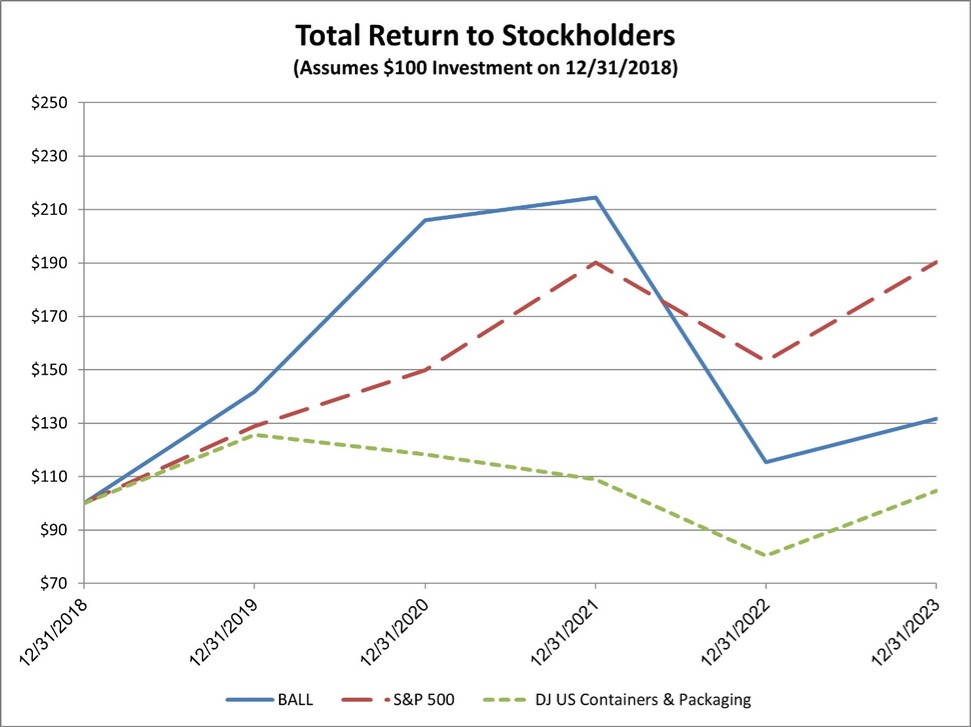Part III
Item 10. Directors, Executive Officers and Corporate Governance.
The executive officers of the company as of February 20, 2024, were as follows:
Nate C. Carey, 45, Vice President and Controller since November 2017; Assistant Controller from 2014 to November 2017.
Carey S. Causey, 46, Senior Vice President and Chief Growth Officer since January 2024; President, Beverage Packaging EMEA from 2021 to 2024; Vice President, Integrated Business Planning from 2020 to 2021; various other positions within the company, 2014 to 2020.
Daniel W. Fisher, 51, Chairman and Chief Executive Officer since April 2023; President and Chief Executive Officer from April 2022 to April 2023; President, Ball Corporation from January 2021 to April 2022; Senior Vice President, Ball Corporation, and Chief Operating Officer, Global Beverage Packaging, from December 2016 to January 2021; President, Beverage Packaging North and Central America from 2014 to 2016; various other positions within the company, 2010 to 2014.
Deron J. Goodwin, 58, Vice President and Treasurer since September 2022; Assistant Treasurer from 2016 to September 2022.
Ronald J. Lewis, 57, Senior Vice President, Chief Supply Chain and Operations Officer since January 2024; Senior Vice President, Ball Corporation, and Chief Operating Officer, Global Beverage Packaging, from 2021 to 2024; President, Beverage Packaging EMEA from 2019 to 2021; Chief Supply Chain Officer, Coca-Cola European Partners plc, 2016 to 2019.
Hannah Lim-Johnson, 52, Senior Vice President, Chief Legal Officer and Corporate Secretary since September 2023; Senior Vice President, Chief Legal Officer and Corporate Secretary, Meritor, Inc., 2020 to 2021.
Kathleen E. Pitre, 47, Senior Vice President and President, North and Central America since January 2024; President, Beverage Packaging North and Central America from 2021 to 2024; Chief Commercial and Sustainability Officer, Global Beverage Packaging from 2019 to 2021; various other positions within the company, 2004 to 2019.
Stacey Valy Panayiotou, 51, Senior Vice President and Chief Human Resources Officer since November 2021; Executive Vice President of Human Resources, Graphic Packaging International from 2019 to 2021; Senior Vice President, Global Talent and Development, The Coca-Cola Company, 2013 to 2019.
Fauze C. Villatoro, 47, Senior Vice President and President, South America since January 2024; President, Beverage Packaging South America from 2022 to 2024; Vice President, Commercial, Beverage Packaging South America from 2020 to 2022; various other positions within the company, 2016 to 2020.
Howard H. Yu, 52, Executive Vice President and Chief Financial Officer since September 2023; Senior Vice President and Chief Financial Officer, Envista Holdings Corporation, 2019 to 2023.
Other information required by Item 10 appearing under the captions “Director Nominees and Continuing Directors” and “Beneficial Ownership,” of the company’s proxy statement to be filed pursuant to Regulation 14A within 120 days after December 31, 2023, is incorporated herein by reference.
Item 11. Executive Compensation
The information required by Item 11 appearing under the caption “Executive Compensation” in the company’s proxy statement, to be filed pursuant to Regulation 14A within 120 days after December 31, 2023, is incorporated herein by reference.
